Asus TUF Gaming A15 FA506QM (R7 5800H, RTX 3060) vs F15 FX506HM (i7-11800H, RTX 3060) review comparison
The TUF Gaming is Asus’s most affordable lineup of gaming and performance laptops, and because of the excellent specs and competitive pricing, one of the most popular laptops on the market.
Over the years, we’ve reviewed multiple versions of the TUF Gaming series, including their 2021 TUF Gaming A15 based on AMD Ryzen and Nvidia RTX hardware, earlier this year.
This article follows up on that one and once more allows us to look at the 2021 TUF A15, this time right next to the newer 2021 TUF Gaming F15 series based on the Tiger Lake 11th gen hardware platform.
Aside from the differences in CPUs, the 2021 A15 and F15 are similar in most ways, but those platform differences impact the everyday experience with these laptops in a couple of different ways, so the article will help you choose between these two TUFs.
Specs as reviewed – ASUS TUF A15 FA506QM vs. F15 FX506HM
2021 ASUS TUF Gaming A15 FA506QM
2021 ASUS TUF Gaming F15 FX506HM
Display
15.6-inch, 1920 x 1080 px IPS 144 Hz, 16:9, non-touch, matte, Panda LM156LF-2F01 panel
15.6-inch, 1920 x 1080 px IPS 144 Hz, 16:9, non-touch, matte, Chi Mei N156HRA-EA1 panel
Processor
AMD Cezanne, up to Ryzen 7 5800H, 8C/16T
Intel Tiger Lake 11th-gen, up to Core i7-11800H, 8C/16T
Video
AMD Radeon Vega + Nvidia GeForce RTX 3060 Laptop 6GB 90-95W
Intel Iris Xe + Nvidia GeForce RTX 3060 Laptop 6GB 90-95W
Memory
up to 32 GB DDR4-3200 (2x DIMMs)
up to 32 GB DDR4-3200 (2x DIMMs)
Storage
2x M.2 PCIe x4 gen3
2x M.2 PCIe x4 gen4
Connectivity
Gigabit LAN (Realtek RTL8168/8111), Wireless 6 (Mediatek MT7921) 2×2, Bluetooth 5.0
Ports
2x USB-A 3.2 gen1, 1x USB-A 2.0, 1x USB-C gen2 with DP and data, HDMI 2.0b, LAN, headphone/mic, Kensington Lock
3x USB-A 3.2 gen1, 1x USB-C with Thunderbolt 4, HDMI 2.0b, LAN, headphone/mic, Kensington Lock
Battery
90 Wh, 200 W power adapter
90 Wh, 200 W power adapter
Size
360 mm or 14.17” (w) x 256 mm or 10.079” (d) x 24.9 mm or .98” (h)
Weight
2.23 kg (4.9 lbs), .59 kg (1.3 lbs) power brick and cables, EU version
Extras
single-zone RGB backlit keyboard, webcam, stereo speakers, available in either Gray (with a metal lid) or Black (with plastic lid)
Update: The TUF Gaming series has been completely revamped for the new year, and you’ll find all about this from this article on the 2022 TUF Gaming A15/F15 series.
Update: Our detailed review of the 2022 TUF Gaming A15 series is available here, and our review of the Intel-based 2022 TUF Gaming F15 is available here.
Design and construction
By now, you’re probably familiar with these TUFs’ design and construction, which hasn’t changed much for more than a year now. Textured plastic is used for the main chassis and undersize, with an option for either a matte-gray metallic exterior or a black plastic exterior, carrying between regions and configurations.
For illustration purpose, our Intel-based TUF F15 gets the black exterior here, and the AMD-based TUF A15 get the gray exterior. However, just to make sure we’re clear about that, both are available in both options. And if possible, go for the gray metal lid; it’s sturdier and does a better job at hiding smudges.
Also, for illustration, the AMD model is on the left side in these pictures, while the Intel model is on the right. There’s also a Ryzen/Core sticker on each one to help you tell them apart.
The brushed plastic used for the interior does feel a bit cheap for 2021, but the build quality is OK, and the Nitro 5 or the Legion 5 are also plastic in this class. They look more serious with their simpler design language, though.
The TUFs are otherwise fairly practical. Two solid hinges keep the screens in place, big rubber feet allow proper grip on the desk, and the edges are friendly on the wrists. The screen can be adjusted single handily but only goes back to about 140 degrees and not all the way back.
Unlike with their ROG models, Asus still offer a camera at the top of the screens here, on that notch-type thicker bezel, but there are no biometrics, and the status LEDs are still annoyingly placed under the display, in the line of sight.
As for the IO, that’s lined mostly on the left side. The Intel-based Tuf F15 series has an edge here with support for Thunderbolt 4 via USB-C and a faster set of USB-A slots, but the two are otherwise identical. Both lack a card reader or the ability to charge via the USB-C ports, so that’s not really a full TB4 port on the F15.
The thermal design is also identical between the two, with intakes from the top and bottom, two fans, and three radiators. This design sets the TUF series apart from the competitors that implement thermal modules with four radiators, and thus can run the components at lower temperatures. We’ll get in-depth about this further down, and we’ll also compare the Nitro 5, Legion 5, and the TUF A15/F15 series in a separate article.
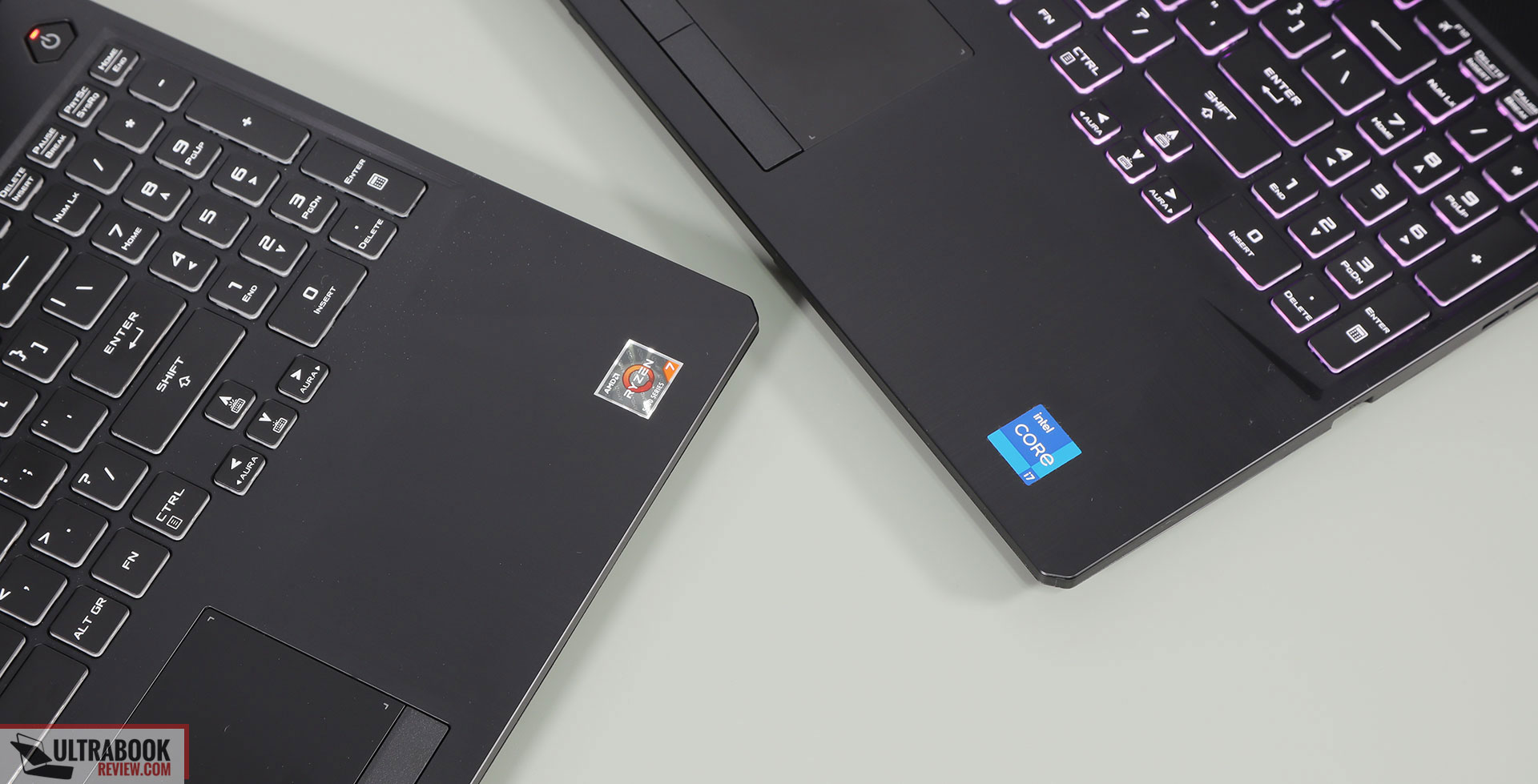
Keyboard and trackpad
The keyboard is also identical between the 2021 A15 and F15 models, with a full layout that includes a NumPad and single-zone RGN illumination. The NumPad section is more cramped than the main set of keys, and the arrows are also fairly small, but overall this is an OK layout.
The smooth plastic keycaps feel nice to the touch and travel 1.8 mm into the frame. The feedback is a little soft and spongy, so might take some time to get used to, but I found these laptops to be reliable and quiet typers after using them for a couple of days.
The keys are RGB backlit, with single-zone control through the AURA software, part of the Armory Crate app. The illumination is uniform, bright-enough, and very little light shines uncontrolled from underneath the keycaps. Asus also made sure to implement a dedicated Caps-Lock indicator.
For mouse, Asus went with an immovable plastic touchpad and dedicated click buttons. The surface is plastic and rather small for this day and age, but it works fine with everyday use, taps, and gestures, and doesn’t rattle with taps. The click buttons are smooth and quiet and work just as expected.
As for biometrics, there are still none on this laptop.
Screen
Asus offer the TUF Gaming series with a couple of different panel options, and you should pay close attention to this aspect, as they differ in terms of color accuracy and response times.
Ideally, you should look for a TUF configuration with the 240 Hz screen, as that’s a fair-quality and fast IPS panel made by Sharp. However, you’ll mostly find that on the RTX 3070 configurations of the A15, sometimes on the 3060 A15s and especially the 3060 F15 models, and rarely on the 3050Ti variants.
Our 3060 configurations are both 144 Hz panels, from different manufacturers. The A15 gets the Panda LM156LF-2F03 panel we’ve experienced in the 2020 A15s, while the F15 gets a Chi Mei N156HRA-EA1 panel that Asus also put on their TUF Dash F15. They’re both bad in terms of color accuracy, at around 60% sRGB coverage. The Chi Mei is a slightly better option, though, with superior blacks, contrast, viewing angles and uniformity. It is dimmer than the Panda panel, at sub-300-nits, while the A15 is plugged in, but darker while the laptop runs on battery, which explains the differences in these images down below.
Here’s what we got in our tests, with an X-Rite i1 Display Pro sensor:
- Panel HardwareID: Chi Mei CMN1521 (N156HRA-EA1);
- Coverage: 63.2% sRGB, 44.0% AdobeRGB, 45.1% DCI-P3;
- Measured gamma: 2.31;
- Max brightness in the middle of the screen: 282.74 cd/m2 on power;
- Min brightness in the middle of the screen: 17.19 cd/m2 on power;
- Contrast at max brightness: 1451:1;
- White point: 7300 K;
- Black on max brightness: 0.19 cd/m2;
- PWM: No;
- Response: ~28 ms GtG (via NBC)
The Panda panel on the AMD model is a little brighter while the laptop is plugged-in, but mediocre in every other way.
- Panel Hardware ID: Panda LM156LF-2F01;
- Coverage: 58.7% sRGB, 40.6% AdobeRGB, 41.7% DCI P3;
- Measured gamma: 1.97;
- Max brightness in the middle of the screen: 314.46 cd/m2 on power;
- Min brightness in the middle of the screen: 17.40 cd/m2 on power;
- Contrast at max brightness: 1000:1;
- White point: 7000 K;
- Black on max brightness: 0.31 cd/m2;
- PWM: No
- Response time: ~34 ms GtG (via NBC)
The two are also poorly calibrated out of the box, and rather slow in games, where you might experience ghosting in fast-paced titles. We also experienced some light bleeding and it was more pronounced on the Chi Mei panel.
Now, these kinds of panels are normally what you’re getting when you’re shopping for fast specs for around 1000-1200 USD/EUR, but unless you plan to connect an external screen most of the time, I’d advise you to look for options with a 100% sRGB panel and faster response times. You’ll get that with the 240Hz panels on the TUF series, as well as some of the 144 Hz panel options available on the Nitro 5 and Legion 5.
Hardware and performance
Our test models are very similar configurations, aside from the CPUs:
- ASUS TUF Gaming A15 FA506QM, built on an AMD Ryzen 7 5800H 8C/16T processor, 16 GB of DDR4 3200 MHz of memory in dual channel (single rank), 512 GB of SSD storage, and dual graphics: the Nvidia RTX 3060 80-95W dGPU and AMD Vega iGPU;
- ASUS TUF Gaming F15 FX506HM, built on an Intel Core i7-11800H 8C/16T processor, 16 GB of DDR4 3200 MHz of memory in dual channel (single rank), 1 TB of SSD storage, and dual graphics: the Nvidia RTX 3060 80-95W dGPU and Intel Iris Xe.
Both are retail units identical to what you can find in stores, and running on the software available as of late July 2021 (BIOS 307 – A15, BIOS 303 – F15, Armoury Crate 4.1.6, GeForce 471.41 drivers).
The Ryzen 7 and Core i7 processors are both 8C/16T with similar traits, and a few differences. As explained in this separate article that takes a closer look at the Core i7-11800H vs the Ryzen 7 5800H, the newer i7 benefits from slightly higher clocks and extra Cache memory, faster PCIe gen4 storage, Thunderbolt 4 support, and a few other advantages over the AMD platform. At the same time, the Zen3 AMD platform is more efficient than the 11th gen Tiger Lake hardware, allowing it to run at lower power, temperatures, and in some cases, fan noise.
You probably noticed that both these laptops ship with single-rank memory, a 2x 8GB kit in dual-channel. This has been documented to impact the performance of the AMD chips, but I’ve yet to properly test their impact on the Intel configurations. Something we’ll follow up on in a separate article.
For the storage, both laptops ship with fast SSDs. There’s PCIe gen4 connection on the Intel model, but both are fast enough for everyday use. Asus didn’t cheap out here, as they used to in the past.
As for the GPUs, both laptops get the same RTX 3060 Laptop dGPU running at 80-95W with Dynamic Boost in the tested titles. The official specs mention a 90-95W GPU implementation, but in our tests, we’ve seen the chip run at 80W in some titles, up to 95W in others. We’ll get in-depth on that further down.
Internally, the two TUFs are similar but not identical, with small layout differences. Getting inside requires you to remove the back panels, and will give you easy access to the two storage drives, the two M.2 SSD slots, and the batteries and thermal modules.

The software package is also the same between the two, with Armoury Crate and MyAsus as the control apps. Silent, Performance, and Turbo profiles are available on both laptops, but without the customizable Manual mode that’s only reserved for the higher-tier ROG products.
As a side note, there’s also no undervolting support in the BIOS on the Intel-based TUF F15, again, something only reserved for the ROG laptops. XTU/Throttlestop don’t allow undervolting either, and Ryzen Master is not supported on the AMD variant.
Asus TUF A15 vs. F15 – Performance and benchmarks
So with that out of the way, we’ll first touch on the sustained CPU performance in the Cinebench loop test, which runs the same test for 15+ times in a loop, with 1-2 sec delay between each run.
We’re looking at similar performance between the two on the top Turbo profile, but 2-4% higher sustained scores on the AMD model, despite the fact that it runs at lower sustained power of 74+W, while the Intel model runs at 79+W. This allows the AMD unit to run slightly quieter, with the fans ramping up to 42-43 dB at head-level, while they ramp to 44-45 dB on the Intel models. The temperatures are the same in both cases, in the high-80s.
The fans get quieter on the Performance profiles in both cases, once more with a noise advantage for the AMD model. However, the Intel configuration runs at higher sustained power on Performance, while the AMD drops to 45W of sustained power after a couple of runs.
On Silent, the CPUs are limited in both cases, at 30W on the Intel model and only 20W on the AMD variant.
Finally, the AMD model performs better while unplugged, on the Performance mode, able to run at 35W sustained, vs. 30W sustained on the Intel model.
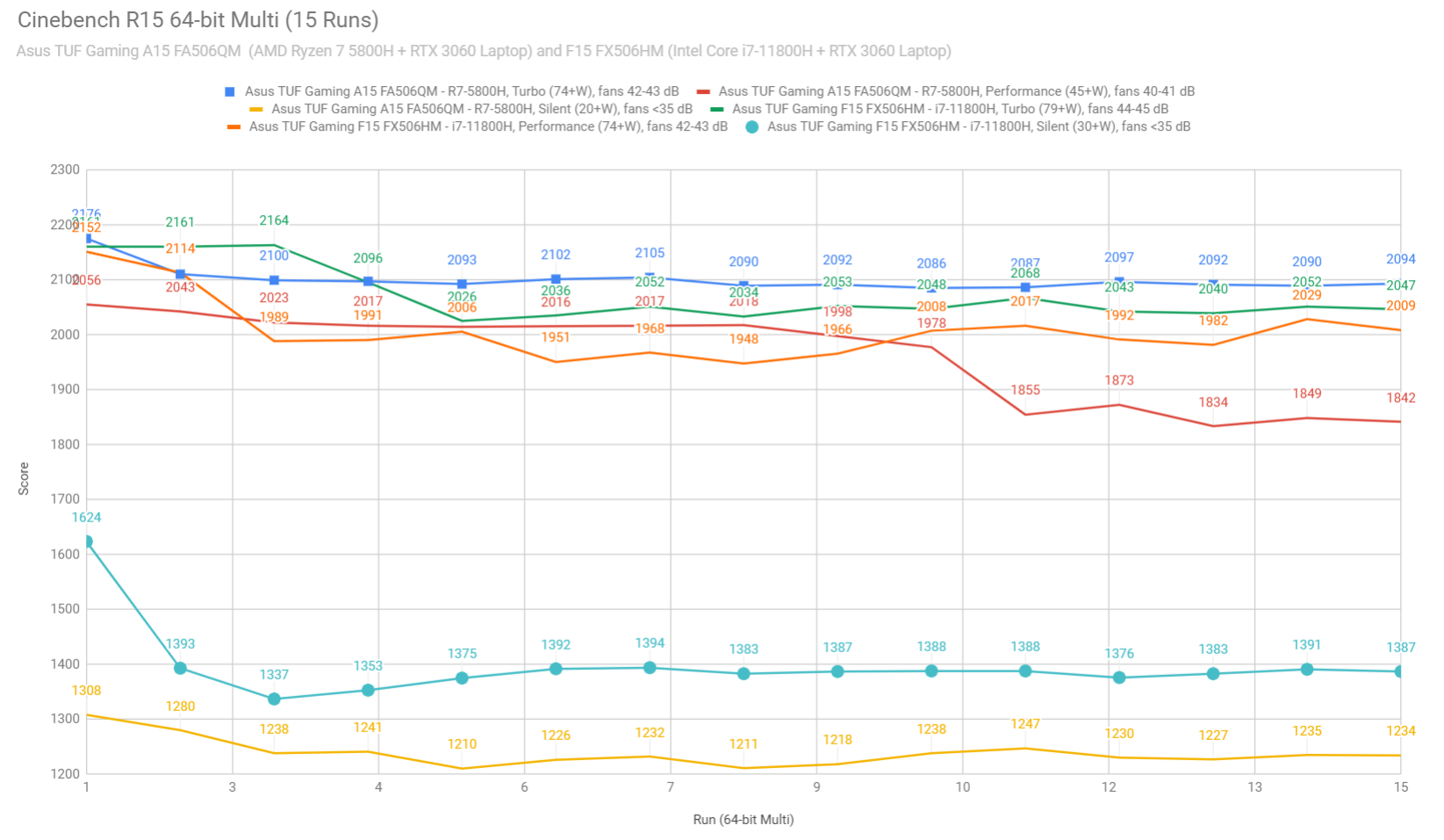
And here’s how the two compare against other modern laptops in their niche.
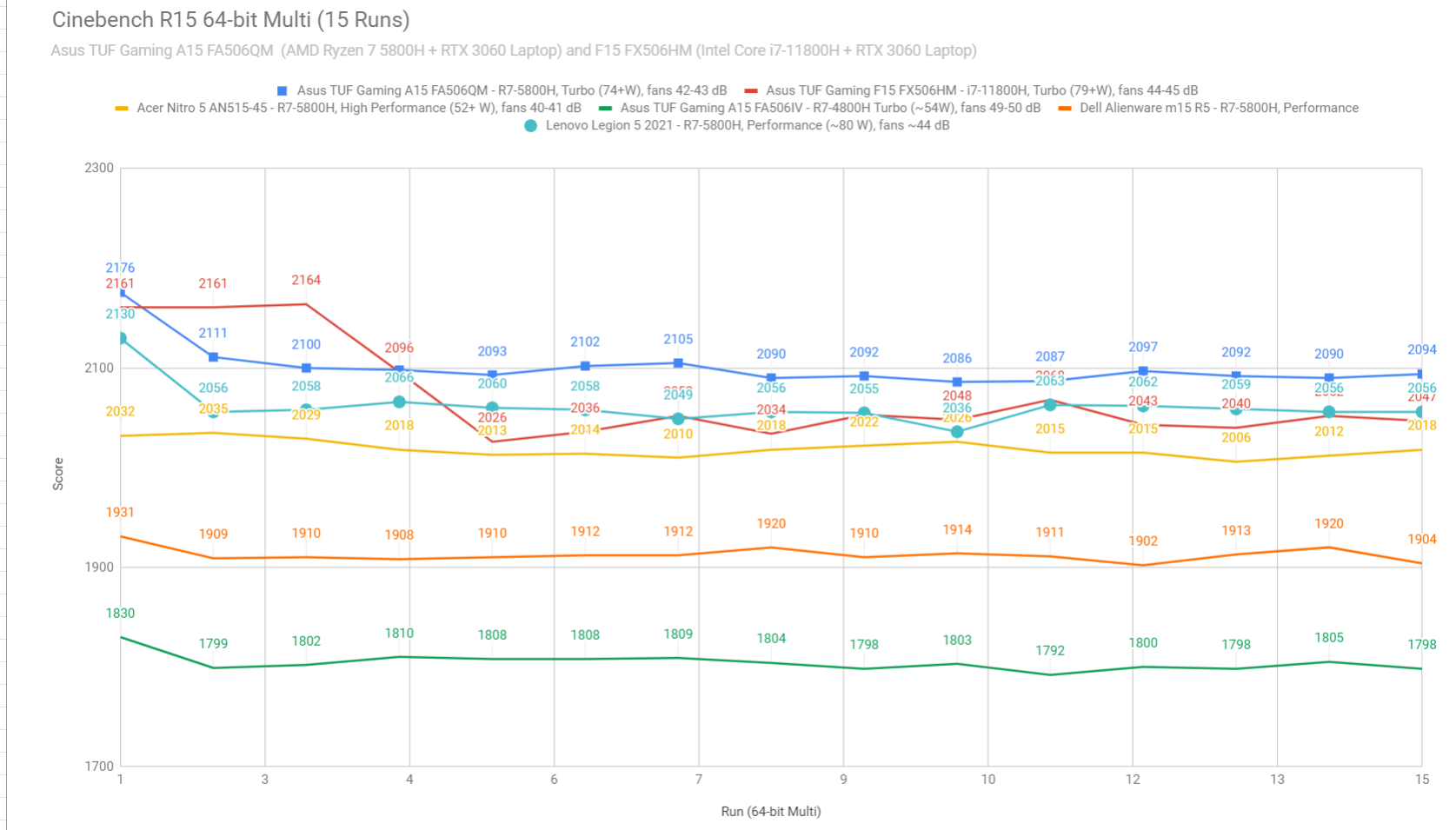
We’ve also confirmed these findings in the more taxing Cinebench R23 test, in which case the CPUs ended running at the same 74+W and 79+W sustained TDPs, but in this case, the Intel CPU scored a little higher than the AMD.
The same happened in the 3DMark CPU profile test, where the Intel i7-11800H won over the AMD R7-5800H across the board, with up to 15% higher scores in some cases.
Finally, we ran the combined 3Dmark stress test on the two units, which loops TimeSpy 20 times in a row and looks for performance degradation as the heat builds up. Both laptops passed the test just fine.
When it comes to the actual benchmark scores, though, the i7 + 3060 F15 configuration wins over the R7 + 3060 model in almost every case, both in the CPU and the GPU scores. There was a higher capacity and faster SSD on the Intel model, which slightly impacted the scores in PassMark and PCMark, but not the others.
I do expect that single-rank memory to have a bigger impact on the more memory dependant AMD platform, though, which could also explain the differences in GPU scores in 3DMark and Uniengine, even though the two GPUs are identical on these two notebooks.
TUF A15 – Ryzen 7 + 3060
TUF F15 – Intel i7 + 3060
3DMark 13 – Fire Strike
17472 (Graphics – 18651, Physics – 23300, Combined – 9448)
18651 (Graphics – 20538, Physics – 23509, Combined – 9331)
3DMark 13 – Port Royal
4411
4669
3DMark 13 – Time Spy
7400 (Graphics – 7218, CPU – 8640)
8066 (Graphics – 7869, CPU – 9406)
Uniengine Superposition – 1080p Medium
13915
14643
Uniengine Superposition – 1080p Extreme
4595
4844
Handbrake 1.3.1 (4K to 1080p encode):
39.78 average fps
43.63 average fps
PassMark10
4894 (CPU: 22598 3D Graphics: 11571, Disk: 16661)
3949 (CPU: 23081 3D Graphics: 13681, Disk: 18068)
PCMark 10
6668 (E – 10333, P – 9022, DCC – 8633)
6799 (E – 10234, P – 8764, DCC – 9509)
GeekBench 5.0.1 64-bit
Single-Core: 1419, Multi-core: 7376
Single-Core: 1545, Multi-core: 8107
CineBench R15 (best run)
CPU 2176 cb, CPU Single Core 230 cb
CPU 2161 cb, CPU Single Core 227 cb
CineBench R20 (best run)
CPU 4901 cb, CPU Single Core 551 cb
CPU 5327 cb, CPU Single Core 572 cb
CineBench R23 (best run)
CPU 12668 cb, CPU Single Core 1395 cb
CPU 13226 cb, CPU Single Core 1494 cb
x265 HD Benchmark 64-bit
29.34 fps
29.48 fps
We also ran some Workstation related loads, on the same Turbo profiles. The differences are small, but once more favor the Intel configuration.
TUF A15 – Ryzen 7 + 3060
TUF F15 – Intel i7 + 3060
Blender 2.90 – BMW Car scene- CPU Compute
3m 22s
3m 9s
Blender 2.90 – Classroom scene – CPU Compute
9m 57s
8m 46s
Blender 2.90 – Classroom scene – GPU, CUDA
3m 37s
2m 20s
SPECviewerf 2020 – 3DSMax
71.67
83.33
SPECviewerf 2020 – Catia
46.53
50.79
SPECviewerf 2020 – Creo
66.1
83.89
SPECviewerf 2020 – Energy
17.49
19.98
SPECviewerf 2020 – Maya
210.33
243.02
SPECviewerf 2020 – Medical
24.75
25.08
SPECviewerf 2020 – SNX
15.25
15.97
SPECviewerf 2020 – SW
138.02
157.52
Gaming results
We also ran a couple of games on our two units, to see how the two CPUs impact the experience in this case. Once more, both units are running on the same kind and amount of RAM (2x 8 GB kit of single rank RAM, in dual channel) and same Nvidia RTX 3060 Laptop dGPU at 80 to 95W of power with Dynamic Boost 2.0, in the supported titles.
Here are some findings at these laptops’ native FHD screen resolution, on the Turbo profiles, and we’ll discuss them further down.
FHD Turbo, Optimus
TUF A15
Ryzen 7 5800H + RTX 3060 80-95W
TUF F15
Core i7-11800H + RTX 3060 80-95W
Battlefield V
(DX 12, Ultra Preset, RTX OFF)
101 fps (51 fps – 1% low)
111 fps (59 fps – 1% low)
Cyberpunk 2077
(DX 12, Ultra Preset, RTX OFF)
52 fps (42 fps – 1% low)
52 fps (40 fps – 1% low)
Dota 2
(DX 11, Best Looking Preset)
112 fps (68 fps – 1% low)
115 fps (72 fps – 1% low)
Far Cry 5
(DX 11, Ultra Preset, SMAA)
97 fps (78 fps – 1% low)
105 fps (81 fps – 1% low)
Metro Exodus
(DX 12, Ultra Preset, RTX OFF)
52 fps (34 fps – 1% low)
52 fps (32 fps – 1% low)
Middle Earth: Shadow of Mordor
137 fps (99 fps – 1% low)
143 fps (100 fps – 1% low)
Red Dead Redemption 2
(DX 12, Ultra Optimized, TAA)
74 fps (51 fps – 1% low)
83 fps (56 fps – 1% low)
Shadow of Tomb Raider
(DX 12, Highest Preset, TAA)
81 fps (42 fps – 1% low)
83 fps (45 fps – 1% low)
Strange Brigade
(Vulkan, Ultra Preset)
138 fps (108 fps – 1% low)
145 fps (111 fps – 1% low)
The Witcher 3: Wild Hunt
(DX 11, Ultra Preset, Hairworks On 4)
94 fps (67 fps – 1% low)
97 fps (68 fps – 1% low)
- Battlefield V, The Witcher 3 – recorded with Fraps/in-game FPS counter in campaign mode;
- Far Cry 5, Middle Earth, Strange Brigade, Red Dead Redemption 2, Tomb Raider games – recorded with the included Benchmark utilities;
- Red Dead Redemption 2 Optimized profile based on these settings.
Those above are rasterization-only tests, and here are some results for RTX titles.
FHD Turbo, Optimus
TUF A15
Ryzen 7 5800H + RTX 3060 80-95W
TUF F15
Core i7-11800H + RTX 3060 80-95W
Battlefield V
(DX 12, Ultra Preset, RTX ON, DLSS OFF)
71 fps (51 fps – 1% low)
75 fps (51 fps – 1% low)
Cyberpunk 2077
(DX 12, Ultra Preset + RTX, DLSS Auto)
41 fps (32 fps – 1% low)
44 fps (35 fps – 1% low)
Shadow of Tomb Raider
(DX 12, Highest Preset, TAA, RTX Ultra)
50 fps (21 fps – 1% low)
57 fps (25 fps – 1% low)
Once more, there’s a small advantage of up to 10% in some titles for the Intel configuration.
However, we noticed quite significant differences between how the two systems handle the various games and how they shift the power between the CPU and GPU with Dynamic Boost 2.0. For the most part, the Intel model tends to allocate more power to the CPU and take out from the GPU, resulting in 5-10W lower GPU power. Given the Intel configuration is newer, and drivers might further tweak this aspect, it is possible for the framerates to improve even further on the Intel model.
For example, with Cyberpunk 2077, the Intel configuration runs at 40W CPU and 85W GPU, while the AMD variant runs at 20W CPU and 95W GPU. Despite that, the recorded framerates are identical between the two. However, the components run at significantly higher temperatures in the Intel laptop.
With Red Dead 2, the Intel model runs at 5W extra power on both the CPU and GPU.
And here are Witcher 3 and FarCry 5 on Turbo.
Overall, while the power allocations vary between the different tested titles, as a whole, the Intel model tends to allocate 5-10W more combined CPU+GPU power to the components on the Turbo profiles, and that’s why it runs internally hotter, especially on the GPU side. The fan noise is similar between the two on Turbo, at around 45-46 dB.
At this point, I think that’s because the Intel model is more recent and runs on less polished software, while the mature AMD configuration has been gimped over the latest BIOS updates in order to keep the thermals at bay and appease the complaints of the thermal module not being apple to cope with the hardware configuration. If that’s the case, I’d expect the Intel model to be slightly limited as well, as right now it tends to run hot, especially on the GPU side, which averages in the mid-80s and close to 87C thermal-throttle limit in all the tested titles.
Just as in our previous takes at these Asus TUF designs, we noticed that raising up both these laptops from the desk allows for a significant decrease of CPU/GPU temperatures and even a slight increase in GPU clocks in some titles. That’s because the small rubber feet choke the intakes while these laptops rest on a desk, and don’t allow for enough fresh air to get into the fans. This makes the A15/F15 series a prime candidate for an external cooling pad, if you plan to run many games on them.
Quieter Performance profiles (42-43 dB) are available on both laptops, with slightly limited CPU and GPU power settings. The components get very hot on both laptops on this profile, around the throttling limit for the GPUs and at 85-95 C on the CPUs, making these profiles hardly usable for gaming.
Silent profiles are also available, limiting the power and performance, while keeping the fan noise around 36-38 dB between the tested titles. The temperatures are fine in this case, but you won’t be able to play most of the modern games at max settings on these Silent profiles.
Finally, you can also run games on these two laptops while unplugged, but the experience is once more limited and your shouldn’t expect more than 1 to maximum 2 hours of battery life on a charge.
Noise, Heat, Connectivity, speakers, and others
The thermal modules and intakes/outputs are very similar between the 2021 TUF A15 and F15 series, as you can tell from the image below.

Both laptops also get open backs with partial cuts over the fans, but because of those low-profile rubber feet on the D panel, the intakes are somewhat choked and that’s why lifting the laptop from the desk allows for better internal temperatures and a slight boost in performance, as explained above.
You do get Turbo, Performance and Silent profiles on these laptops, with similar fan settings: 45-46 dB at head-level on Turbo, 42-43 dB on Performance, and 36-38 dB on Silent. Based on our samples, the internal and external temperatures differ between the A15 and F15 configurations, mostly because the F15 runs at higher CPU+GPU power. That might change with future updates.
Gaming aside, the two laptops are a smooth experience switch everyday use, as the Silent profile allows the fans to switch off as long as the hardware doesn’t go above 60 C, with a toll on the overall snappiness. The fans spin on the Performance profile with daily multitasking, but never get very loud. I also haven’t experienced any coil whine on these two TUFs, but that’s no guarantee you won’t get any on yours, so make sure to properly test for it.
Here’s what to expect in terms of external temperatures on this chassis:
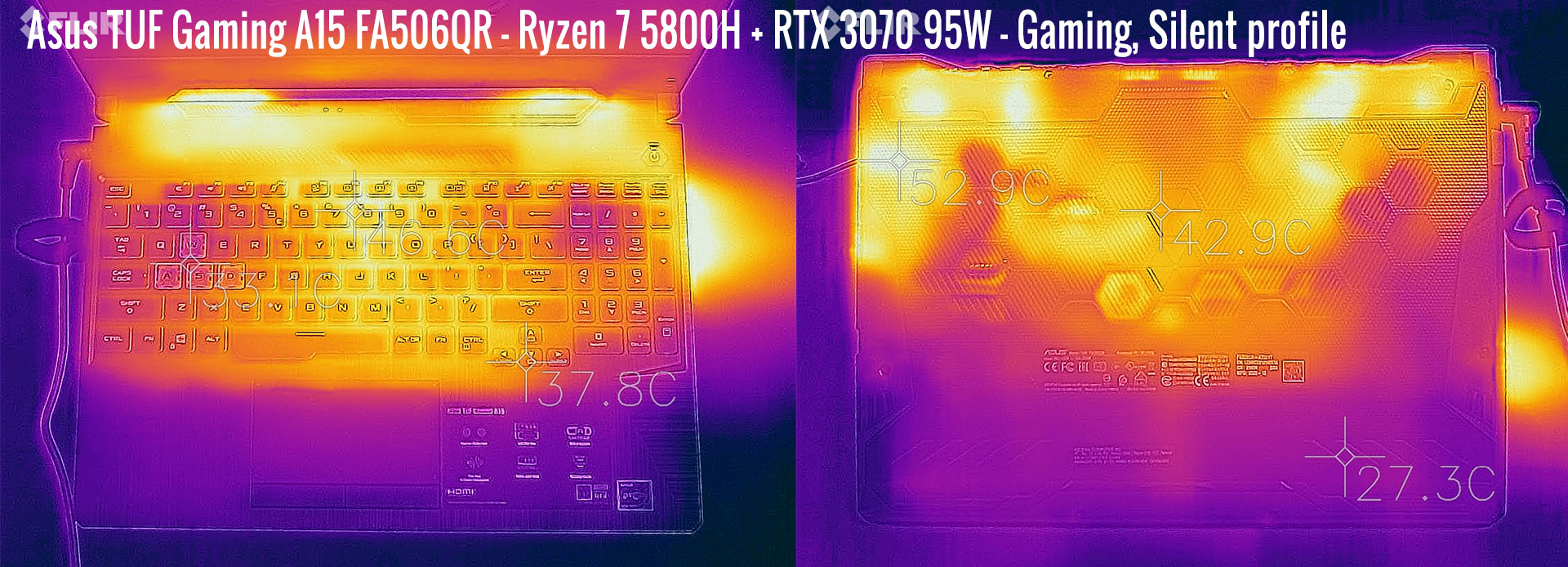
And here are the gaming FLIR readings.
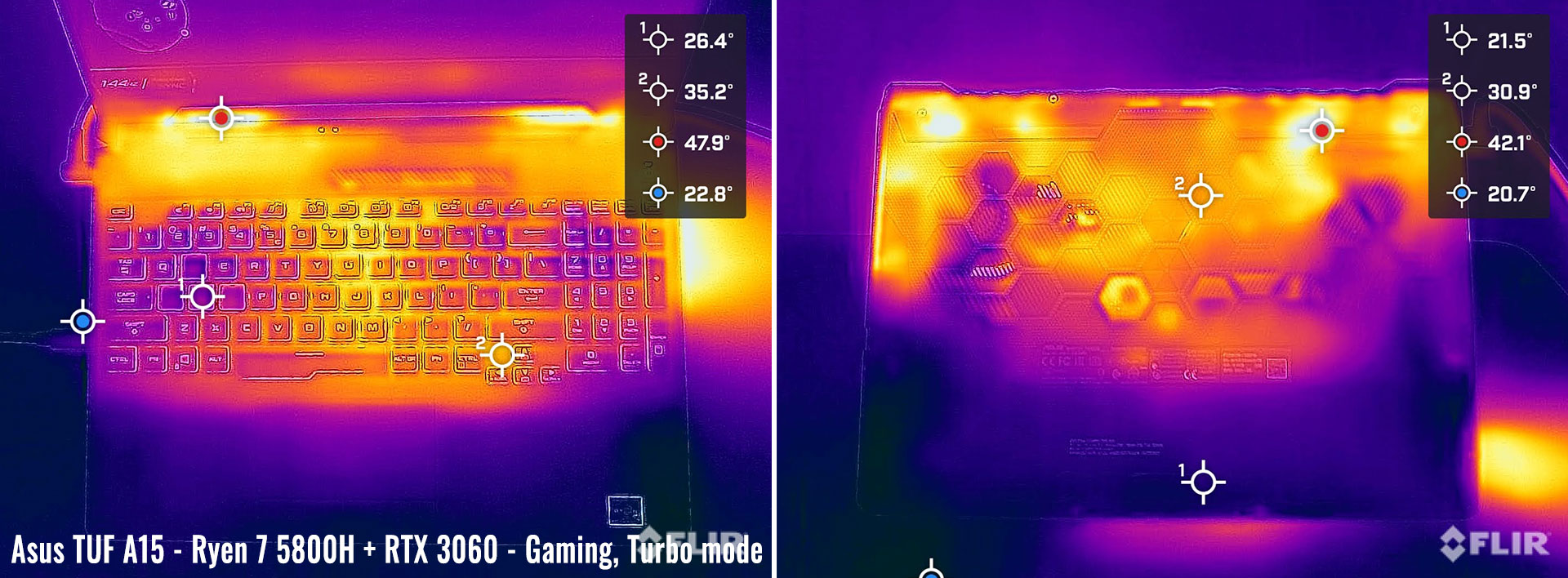
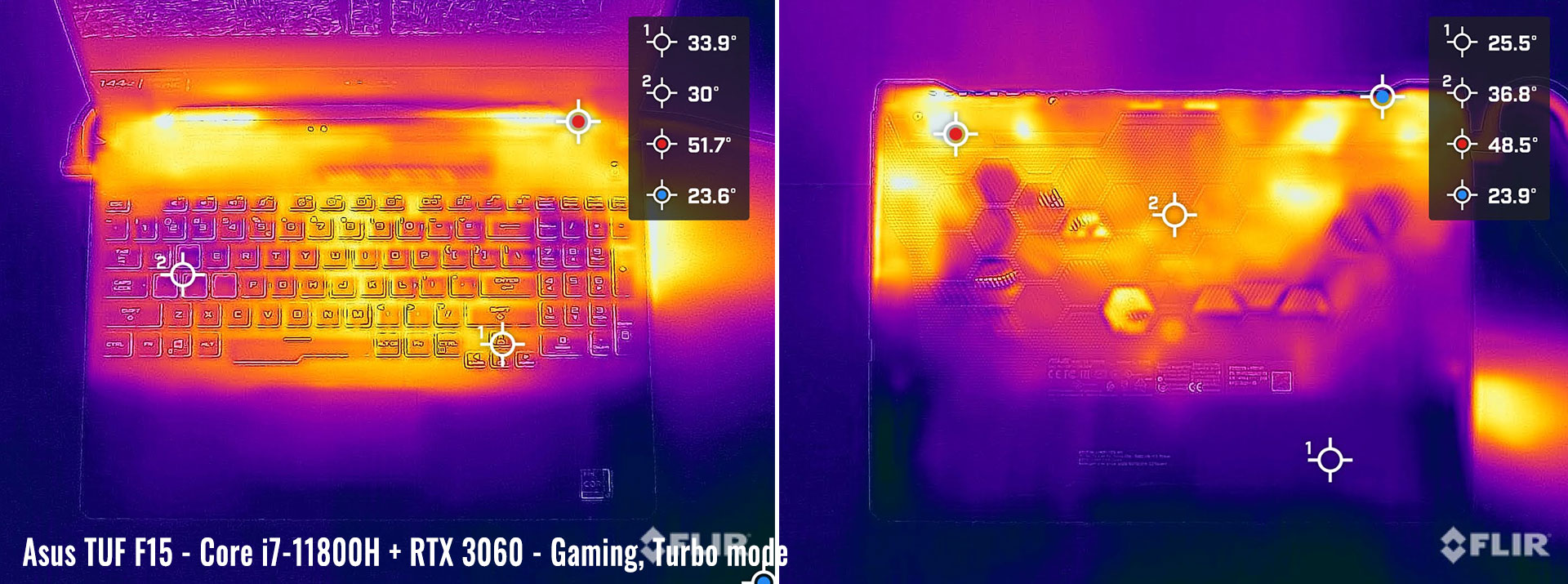
*Gaming – both laptops on Turbo, on desk – playing Red Dead 2 for 30 minutes, fans at 45-46 dB
For connectivity, there’s Wireless 6 and Bluetooth 5 through Mediatek chips on both these units, as well as Gigabit Lan through a Realtek chip. The WiFi module is not the fastest out there, but it performed OK both near the router and at 30+ feet with obstacles in between.
The audio hasn’t changed from the previous TUF A15s and is about average for a mid-tier gaming laptop, with only middling volumes of 75-77 dB at head-level and little bass. Don’t expect much on this front.
Finally, the camera is placed on top of the screen, flanked by microphones. It’s OK for occasional calls, but grainy, so again, not much.
Battery life
There are 90Wh batteries inside all the 2021 TUF Gaming A15 and F15 variants.
Here’s what we got in terms of battery life on the AMD-based TUF A15, with the screen’s brightness set at around 120 nits (~80 brightness).
- 12.5 W (~6-7 h of use) – text editing in Google Drive, Silent Mode, screen at 80%, Wi-Fi ON;
- 8 W (~11+ h of use) – 1080p fullscreen video on Youtube in Edge, Silent Mode, screen at 80%, Wi-Fi ON;
- 7 W (~12+ h of use) – Netflix fullscreen in Edge, Silent Mode, screen at 80%, Wi-Fi ON;
- 15 W (~4-6 h of use) – browsing in Edge, Performance Mode, screen at 80%, Wi-Fi ON;
- 60 W (~1+ h of use) – Gaming – Witcher 3, Performance Mode, screen at 80%, Wi-Fi ON, no fps limit.
And here are the same tests on the Intel-based TUF F15, with the screen’s brightness set at around 120 nits at as well (~70 brightness).
- 14 W (~5-6 h of use) – text editing in Google Drive, Silent Mode, screen at 70%, Wi-Fi ON;
- 12.5 W (~7+ h of use) – 1080p fullscreen video on Youtube in Edge, Silent Mode, screen at 70%, Wi-Fi ON;
- 10.5 W (~8+ h of use) – Netflix fullscreen in Edge, Silent Mode, screen at 70%, Wi-Fi ON;
- 18 W (~4-5 h of use) – browsing in Edge, Performance Mode, screen at 70%, Wi-Fi ON;
- 60 W (~1+ h of use) – Gaming – Witcher 3, Performance Mode, screen at 70%, Wi-Fi ON, no fps limit.
There’s no surprise the AMD model is more efficient with light loads and video streaming, and the differences are significant. With word processing, daily browsing, and multitasking, though, the two are a lot closer in efficiency, with still a slight edge for the AMD model.
For what is worth, the system automatically switches the screen to 60Hz while on battery and on the iGPU on both, something I wish every manufacturer would implement on their products.
Both configurations are bundled with 200W power-bricks, fairly compact for what they are. The battery fills up in about 2 hours, with fast charging for the first half an hour, and USB-C charging is not supported.

Price and availability
These 2021 TUF Gaming A15 and F15 are available in stores in most regions of the world, but the configurations differ from country to country. Follow this link for updated configurations and prices in your region at the time you’re reading this article.
Over here, these 3060 models go for around 1100 EUR for the TUF A15 and around 1250 EUR for the TUF F15, but the latter with the 240 Hz screen. More affordable RTX 3050Ti configurations are also available, but you’ll get the best bang for your buck with the 3060s. Just try to find a configuration with that 240 Hz screen, it’s a much nicer panel overall.
As a whole, expect the Intel-based F15 models to sell for a little more than the A15s for matching specs, mostly because the A15s have been around for a while now and are now discounted, while the newer F15s are not. The slight performance gains might be worth the premium, but the AMD configurations might still be the better-balanced options, with their more efficient and cooler running hardware, and you can spend the difference to upgrade the RAM to a dual-rank kit.
Final thoughts- 2021 Asus TUF Gaming A15 and F15 reviews
So as mentioned in the previous paragraph, having spent time with both these variations of the TUF A15 and TUF F15 series, I’m still (in theory, and I’ll explain why in a bit) leaning towards the AMD-based A15 right now, as it’s a more mature product running on a more mature hardware/software platform, more widely available and more affordable.
The Intel model ends up outmatching the AMD variant in our benchmarks and tests, but it also runs hotter internally, and I’d expect that upgrading the memory to a dual-rank kit would bring the A15 much closer in results to the F15. You can do that with the 100 USD/EUR or so left from getting the cheaper A15.
In real life, though, it’s challenging to find an RTX 3060 configuration of the A15 paired with the 240 Hz screen, as most get the 144 Hz panel option instead, which is the measly Panda that I’d rather avoid. You will find the 240hz screen on the 3070 configurations, but those are also more expensive. The 3060 F15, on the other hand, seems to be mostly paired with this much better 240 Hz screen with 100% sRGB color coverage, and that alone is worth paying extra for.
At the same time, the TUF series faces tough competition from strong products such as the Lenovo Legion 5 or the Acer Nitro 5. Both are solid designs available with either AMD Ryzen or Intel Core hardware, both are competitively priced and possibly easier to find with a good screen on a 3060 configuration. The configuration and prices vary between regions, though, so there’s no way to tell one’s a better buy than the other; you just have to consider all of them when shopping in this niche and pick the one that best fits your needs and local budget. I will put up a separate article on the two for a more in-depth look at how they fare against each other.
So all in all, these 2021 Asus Gaming TUF A15 and F15 lineups are competitive notebooks in their segments. The AMD-based A15 is the more efficient, cooler-running, and more affordable option, while the Intel-based F15 is the more powerful in our benchmarks and gaming tests. Careful that both ship with single-rank memory, and upgrading it would positively impact the results in both cases, especially on the AMD configuration. Also, try to get the 240 Hz screen option if possible; the 144 Hz panels are poor-quality on both these TUF variations.
With that in mind, we’ll wrap up this review here, but I’d love to hear your thoughts on these two Asus TUF Gaming laptops and which would you choose and why, so get in touch with your feedback or questions in the comments section down below.
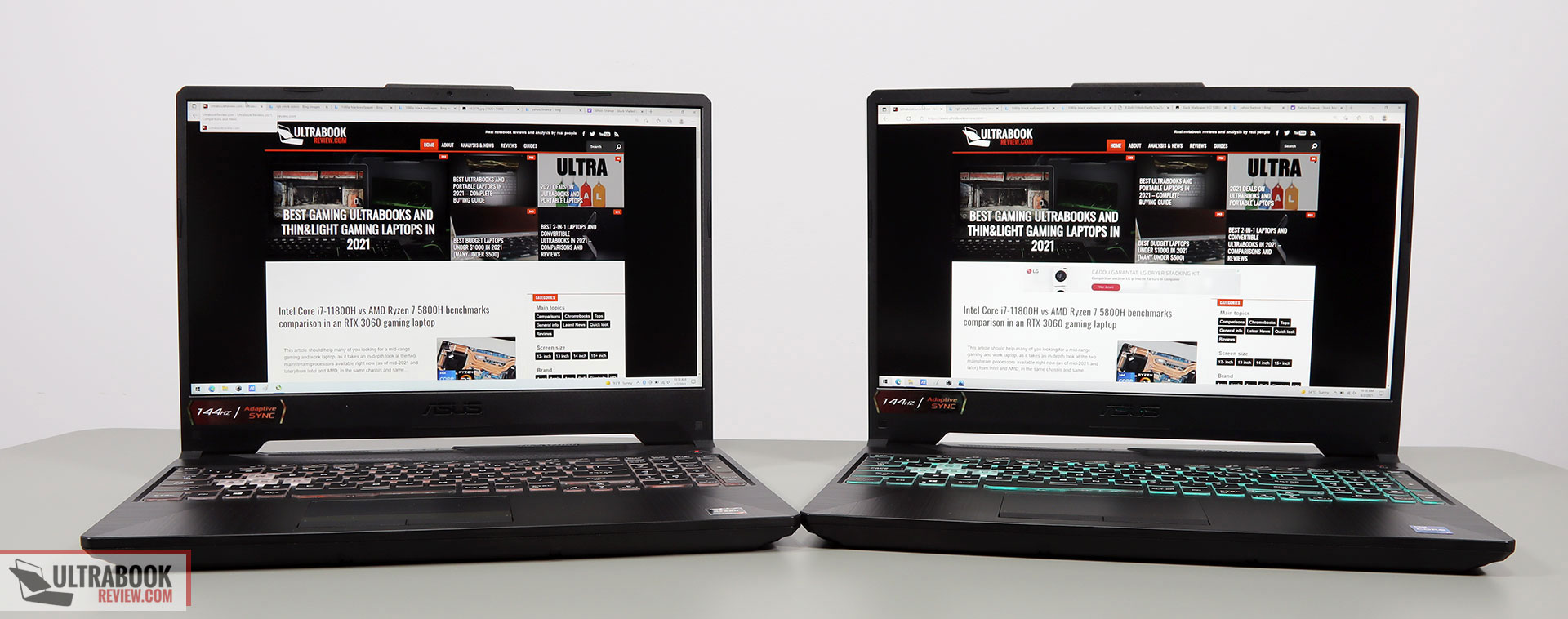
Disclaimer: Our content is reader-supported. If you buy through some of the links on our site, we may earn a commission.
Navigation: Ultrabookreview.com » 15.6 inch or larger
Our content is reader-supported. If you buy through some of the links on our site, we may earn a commission. Terms


Review by: Andrei Girbea
Andrei Girbea, Editor-in-Chief. I’ve a Bachelor’s in Computer Engineering and I’ve been covering mobile technology since the 2000s. You’ll mostly find reviews and thorough guides written by me here on the site, as well as some occasional first-impression articles.
. I’ve a Bachelor’s in Computer Engineering and I’ve been covering mobile technology since the 2000s. You’ll mostly find reviews and thorough guides written by me here on the site, as well as some occasional first-impression articles.






